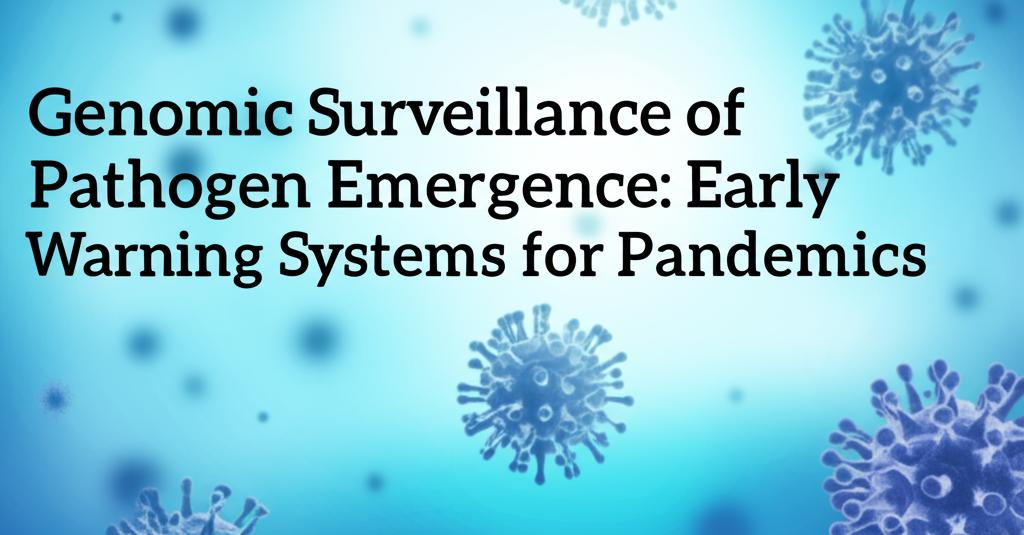The COVID-19 pandemic starkly highlighted the critical role of genomic surveillance in rapidly identifying and tracking novel pathogens, guiding public health responses, and accelerating vaccine and treatment development. Building on the immense advancements in pathogen sequencing and bioinformatics spurred by the pandemic, genomic surveillance is now central to ongoing public health efforts and a cornerstone of preparedness for future epidemics and pandemics.
Current Landscape and Key AdvancementsGenomic surveillance involves the continuous monitoring of pathogen genomes to detect new variants, understand transmission dynamics, and assess the evolution of virulence or antimicrobial resistance. This "genetic fingerprinting" provides invaluable, near real-time insights that shift public health from a reactive to a proactive stance.
Recent advancements include:
- Enhanced Sequencing Capacity: The global capacity for whole-genome sequencing (WGS) has expanded significantly. Technologies like long-read sequencing (LRS) are revolutionizing the field by enabling more accurate and rapid analysis of complex genomic structures and antimicrobial resistance determinants.
- Wastewater Surveillance: Monitoring wastewater for pathogen genomic material has emerged as a cost-effective and non-invasive method to track community-level transmission, including asymptomatic infections. The U.S. CDC's Aquascope pipeline, for example, facilitates faster and more scalable analysis of viral lineages from sewage.
- Integration of Artificial Intelligence (AI) and Big Data: AI and machine learning are transforming genomic surveillance by enabling rapid analysis of vast datasets to predict outbreaks, model transmission, identify new variants, and optimize public health interventions. Protein language models (pLMs) show particular promise in making genomic surveillance more effective and less costly.
- The "One Health" Approach: There's a growing emphasis on a "One Health" approach, recognizing the interconnectedness of human, animal, and environmental health. Genomic surveillance is crucial for monitoring pathogens at the human-animal-environment interface, detecting zoonotic spillovers, and tracking antimicrobial resistance across these domains.
- Global Collaboration and Data Sharing: Initiatives like the WHO's Global Genomic Surveillance Strategy (2022-2032) and platforms such as GISAID are fostering international collaboration, data sharing, and capacity building. Successful public-private partnerships are also expanding surveillance efforts, such as airport-based pathogen monitoring programs.
Significant efforts are underway globally to strengthen genomic surveillance infrastructure and expertise, particularly in low- and middle-income countries. This includes training researchers, establishing sequencing laboratories, and developing robust data systems. For instance, the Africa CDC and various partners are working to equip all 55 National Public Health Institutes in Africa with operational Next-Generation Sequencing (NGS) capacity. Fiji recently launched its own pathogen genomics laboratory, enhancing its in-country capabilities.
Key challenges remain, including:
- Sustainable Funding and Resources: Ensuring long-term funding and resources beyond pandemic crises is crucial to maintain and enhance genomic surveillance capabilities.
- Data Harmonization and Interoperability: Standardizing methodologies and ensuring data can be seamlessly shared and analyzed across different systems and countries is vital for effective global surveillance.
- Equity in Access: Bridging the gap in genomic surveillance capacity between high-income and lower-resourced nations is a priority.
- Ethical Data Sharing: Balancing open data sharing for public health with data sovereignty and privacy concerns is an ongoing discussion.
The future of genomic surveillance will likely see even greater integration of AI, expansion of environmental surveillance (like wastewater and air sampling), and a stronger focus on pre-emptive identification of potential threats through global pathogen discovery efforts. By continuing to invest in and refine these early warning systems, the global community can be better prepared to rapidly respond to and mitigate the impact of emerging pathogens.

